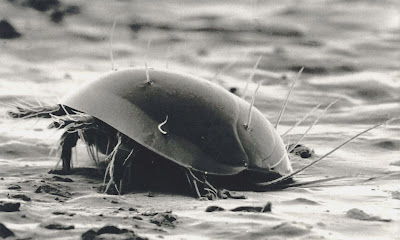Today's subjects, the Pygmephoroidea, are an assemblage of mites that are mostly free-living feeders on fungi, though exceptions occur. The taxonomic coverage of Pygmephoroidea does vary a bit between systems: Walter et al. (2009) divide the taxa covered in this post between two superfamilies Pygmephoroidea and Scutacaroidea, but Khaustov & Ermilov (2011) combine them all in the one superfamily. Taxonomy of the pygmephoroids is further complicated by presence in many species of distinct adult female forms, some of which were different enough to have been placed by past authors into different families. The normal adult female is a fairly sedentary individual, but other females are what are referred to as 'phoretomorphs', specialised to be able to disperse by hitching a ride on other animals (most commonly larger arthropods), a process known as 'phoresy'. Phoretomorphs tend to be more heavily sclerotised than the normal females, and may also differ in features such as fusion of the tibia and tarsus of the first pair of legs, and enlargement of the claws on the second and third pairs. For the most part, phoretic mites are only passengers of their hosts, and do not cause them any noticeable harm. However, some pygmephoroids in the family Microdispidae have become parasites.
Video of the life cycle of the pygmephorid Pediculaster mesembrinae.
Like ants and wasps, pygmephoroids have what is called a haplodiploid system of sex determination where unfertilised eggs hatch into haploid males and fertilised eggs into diploid females (Camerik et al. 2006). Only larvae and adult females feed; adult males live only to mate. In between the active larval and adult stages of the pygmephoroid life cycle is a quiescent nymphal stage (comparable to the pupal stage in insect development). Adult males of the family Scutacaridae will pick up a quiescent female nymph and carry her until she moults to adulthood and is ready for mating. After mating, normal females of Pygmephoridae and Microdispidae become physogastric: the hind part of their body swells up to relatively enormous size as their eggs develop within them; females of the pygmephorid Siteroptes ceralium may produce up to 500 offspring each (Scutacaridae swell slightly, but not to the extent of the other two families; phoretic females do not generally become physogastric until after they've left their dispersal host). In the microdispid genera Glyphidomastax and Perperipes, that feed on the larvae or eggs of the army ants they live with, the elongate physogastric body may mimic a young ant larva (Walter et al. 2009). In at least some species of Pygmephoridae, the progeny of a female will develop through the larval stage while still within the mother, and emerge at or close to maturity (a process that often involves the mother literally bursting open; even if it doesn't, pygmephoroid females do not survive long past egg-laying). As previously discussed in the related mite Acarophenax, males and females may even copulate while still inside their mother. In the pygmephorid Xenaster longiabdominalis, copulation occurs outside the mother, but the fully developed males are already grabbing their unmated sisters and carrying them away at the time of birth (Walter et al. 2009).
Some pygmephoroids such as the microdispid Microdispus lambi and the pygmephorid Pediculaster flechtmanni can cause damage to commercial mushroom crops. Other species are vectors of plant diseases, such as Siteroptes cerealium spreading carnation bud rot. The phoretomorphs of many pygmephorids possess structures on their underside to carry spores of their preferred food fungus with them as they travel; in a number of cases, the fungus in question happens to be a plant pathogen.
REFERENCES
Camerik, A. M., E. de Lillo & C. Lalkhan. 2006. The neotype of Pediculaster mesembrinae (Canestrini, 1881) (Acari: Siteroptidae) and the description of all life stages. International Journal of Acarology 32 (1): 45-67.
Khaustov, A. A., & S. G. Ermilov. 2011. A new species of the genus Siteroptes (Acari, Heterostigmata, Pygmephoridae) from European Russia. Zoologicheskii Zhurnal 90 (6): 756-760 (transl. Entomological Review 91 (4): 528-532.
Walter, D. E., E. E. Lindquist, I. M. Smith, D. R. Cook & G. W. Krantz. 2009. Order Trombidiformes. In: Krantz, G. W., & D. E. Walter (eds) A Manual of Acarology, 3rd ed., pp. 233-420. Texas Tech University Press.


















What determines if a female turns into a phoretomorph?
ReplyDeleteProbably declining food supply, for the most part. Like how aphids switch to the winged morph as winter approaches.
ReplyDelete